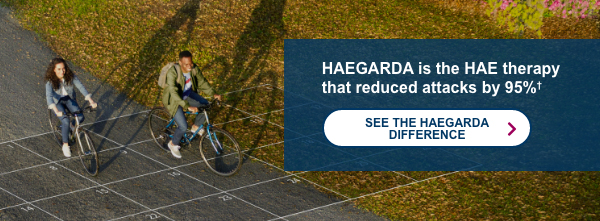TREAT YOUR DISEASE—
NOT JUST YOUR SYMPTOMS
WITH HAEGARDA |
|
|
|
|
Discover the #1 prescribed
C1-INH therapy, addressing
the root cause of HAE |
|
|
| |
| Please see Important Safety Information below |
| |
| In clinical studies, the most common side effects reported with HAEGARDA were injection-site reactions (pain, redness, swelling); hypersensitivity (itching and rash), dizziness, and nasal symptoms, including stuffy or runny nose and sneezing. |
| |
|
| |
HAEGARDA treats the primary cause of HAE,
not just the symptoms of an attack. |
| |
HAE attacks can occur when your levels of C1-inhibitor (C1-INH)—a key
protein in your body that controls swelling are too low or non-functioning.
HAEGARDA brings your working C1-INH levels back up and closer to
normal, reducing your risk of an HAE attack. |
| |
|
| |
|
 |
| #1 PRESCRIBED |
| |
HAEGARDA is the #1 prescribed C1-INH preventive
therapy addressing HAE at its root cause. |
| |
 |
| |
|
| |
|
|
Having a therapy that
addresses the root cause of
HAE is important to me. It''s
like filling in the missing
puzzle piece of C1-INH
my body doesn''t make.” |
| |
| - Cheryl F, HAEGARDA Advocate*
|
|
|
| |
 |
HAE attacks can occur when your levels of working
C1-INH are too low |
| |
HAEGARDA brings your working C1-INH levels
back up and closer to normal, reducing your risk of an HAE attack |
| |
|
| |
|
|
| |
HAEGARDA is the #1 prescribed C1-INH therapy in
the US for the prevention of HAE attacks. |
| |
|
|
| |
| Ready to talk to your doctor about HAEGARDA? |
| |
| You should always have HAE rescue medication available at all times in case of a breakthrough attack.
|
| |
 |
| |
|
|
| |
| * |
Advocates are not healthcare providers or medical experts, and are compensated for their participation. For medical questions, you should contact your physician. |
| |
|
Median reduction in number of attacks in patients receiving 60 IU/kg of HAEGARDA vs placebo. |
| |
|
Median reduction in rescue medication use in patients receiving 60 IU/kg of HAEGARDA vs placebo. |
|
| |
|
|
| |
 |
| |
| |
| Important Safety Information |
| |
| HAEGARDA®, C1 Esterase Inhibitor Subcutaneous (Human), is an injectable medicine used to prevent swelling and/or painful attacks in patients 6 years of age and older with Hereditary Angioedema (HAE). |
| |
| A healthcare professional can teach you (or caregiver) to self-administer HAEGARDA for prophylaxis. Do not use HAEGARDA to treat an acute HAE attack once it starts; work with your physician to plan for attacks if they occur. |
| |
| Do not use HAEGARDA if you have previously experienced life-threatening immediate hypersensitivity reactions, such as shock, to HAEGARDA or other C1-INH products. |
| |
| Immediately report any symptoms of allergic reactions to HAEGARDA, including hives, chest tightness, wheezing, difficulty breathing, turning blue, faintness, facial swelling and fast heartbeat. |
| |
| Before starting HAEGARDA, tell your healthcare provider about all medical conditions you have–including pregnancy or nursing; a history of heart disease or stroke; an indwelling catheter/access device in a vein; or immobilization for a sustained period. Also tell your physician about any other medications you are taking, as some medications, such as birth control pills and certain androgens, can increase risk of clotting problems. High doses of C1-INH have been known to increase the risk of blood clots. |
| |
| Immediately report to your physician or an emergency room if you have any of the following symptoms of a blood clot: pain or swelling of arm or leg, with warmth or discoloration over the affected area; unexplained shortness of breath; chest pain or discomfort that worsens on deep breathing; rapid pulse; and numbness or weakness on one side of the body. |
| |
| In clinical studies, the most common side effects reported with HAEGARDA were injection-site reactions (pain, redness, swelling); hypersensitivity (itching and rash), dizziness, and nasal symptoms, including stuffy or runny nose and sneezing. These are not the only side effects possible with HAEGARDA. Tell your healthcare provider about any side effect that bothers you or does not go away. |
| |
| Because HAEGARDA is made from human blood, the risk that it may transmit infectious agents, including viruses and theoretically, the agents of Creutzfeldt-Jakob Disease (CJD) and its variant form (vCJD), cannot be completely eliminated. |
| |
| Please see full prescribing information for HAEGARDA, including patient product information. |
| |
You are encouraged to report negative side effects of prescription drugs to the FDA.
Visit www.fda.gov/medwatch, or call 1‑800‑FDA‑1088. |
| |
You can also report side effects to CSL Behring''s Pharmacovigilance Department at
1‑866‑915‑6958. |
| |
| This email has been sent to you because we believe this information may be of value to you. If you no longer wish to receive these email communications, you may unsubscribe at any time. |
| |
| View in a web browser |
| |
 |
| |
HAEGARDA is manufactured by CSL Behring GmbH and distributed by CSL Behring LLC.
HAEGARDA® is a registered trademark of CSL Behring GmbH.
HAEGARDA ConnectSM is a service mark of CSL Behring LLC.
Biotherapies for Life® is a registered trademark of CSL Behring LLC. |
| |
| ©2020 CSL Behring LLC. |
| |
| 1020 First Avenue, PO Box 61501, King of Prussia, PA 19406-0901 USA |
| |
| www.CSLBehring.com HGD-1002-SEP20 |
| |
|
|
|














 Arts and Entertainment
Arts and Entertainment Business and Industry
Business and Industry Computer and Electronics
Computer and Electronics Games
Games Health
Health Internet and Telecom
Internet and Telecom Shopping
Shopping Sports
Sports Travel
Travel More
More